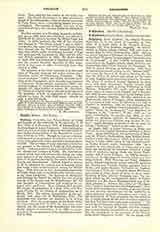

Dalgairns, JOHN DOBREE (in religion FATHER BERNARD), b. in the island of Guernsey, October 21, 1818; d. April 6, 1876, at St. George’s Retreat, Burgess Hill, near Brighton, England. He matriculated at Exeter college, Oxford, 1836, and took a second class in literis humanioribus, 1839. Already an ardent follower of Newman, he had written (1838) to the Paris “Univers” a letter signed “jeune membre de l’Universite”, on the Catholic movement then spreading in the English Church, which elicited a correspondence with Father Dominic the Passionist. In 1842 he joined Newman at Littlemore; while there he contributed several articles to the “British Critic” and wrote the Lives of St. Stephen Harding, St. Gilbert, St. Helier, St. Aelred, and others for the series of early English saints then being edited by Newman. The grasp of medieval history displayed in these lives, and their picturesque setting evoked high praise even from such a strong Protestant as Dean Milman. Dalgairns’s life, work, and studies had drawn him ever closer to the Church, and in September, 1845, he was received into it by his former correspondent, Father Dominic. He then repaired to the Abbe Jovain, canon of Langres, whose acquaintance he had made in 1841 when the abbe was on a visit to Oxford; in December, 1846, he was ordained priest at Langres. A worthless French translation of Newman’s “Essay on Development” was described by Dalgairns in the “Univers”, January 10, 1847, as “un amas inintelligible de paroles sans idees, et dans lequel en plusieurs endroits le traducteur avait donne une apparence d’heresie aux phrases de l’auteur”, words strangely prophetic of the use made by certain “Modernist” writers of the same work.
At Easter, 1847, he joined Newman in Rome and entered the new English Oratorian novitiate at Santa Croce. As an Oratorian he was successively at Mary-vale, St. Wilfrid’s, Staffordshire, King William Street, London (1849), Birmingham (1853), and South Kensington, London (1856), where he was elected superior on Father Faber’s death, September, 1863. As a preacher he was second only to Faber and as a confessor his knowledge of languages attracted a large circle of penitents, among whom was Queen Marie-Amelie, wife of Louis Philippe. In 1869 he became a member of the Metaphysical Society which was then being formed. With Manning and Ward, Dalgairns had to defend Catholicism against scientific agnostics like Huxley and Tyndall, literary agnostics such as Morley and Leslie Stephen, Thompson the Anglican Archbishop of York, the Unitarian James Martineau, and others of every shade of creed or of no creed. Speaking of these debates Thompson says, “he was more struck by the metaphysical ability of Father Dalgairns and Mr. James Martineau than any of the other debaters”. Hutton, then editor of “The Spectator,” says of Dalgairns and his coreligionists, “there was in their countenance a blending of genuine humility and genuine thankfulness for the authority on which they had anchored themselves and a sense of the redundance of their provisions for the spiritual life, of which almost all the other members seemed to feel they had but a bare and scanty pasturage”. His knowledge of Christian philosohpy, and his acquaintance with the writings of German scientists enabled him to meet Huxley successfully on his own grounds. But the attendance at the meetings of the Society broke down Dalgairns’s health. He was struck with paralysis, and he died after a year’s lingering mental illness. Hutton describes him as “a man of singular sweetness and openness of character with something of a French type of playfulness of expression”. His best known works are “The Devotion to the Sacred Heart of Jesus” (London, 1853); “The Holy Communion” (Dublin, 1861); “The German Mystics of the Fourteenth Century” (London, 1858).
SEBASTIAN BOWDEN

